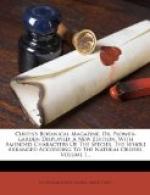LEAVES numerous, standing upright on their footstalks,
about a foot in
length, and four
inches in breadth, ovato-oblong, coriaceous,
somewhat fleshy,
rigid, smooth, concave, entire on the edges,
except on one
side towards the base, where they are more or less
curled, on the
upper side of a deep green colour, on the under
side covered with
a fine glaucous meal, midrib hollow above and
yellowish, veins
unbranched, prominent on the inside, and
impressed on the
outside of the leaf, young leaves rolled up.
LEAF-STALKS about thrice the length of the leaves,
upright, somewhat
flattened, at
bottom furnished with a sheath, and received into
each other, all
radical.
SCAPUS or flowering stem unbranched, somewhat taller
than the leaves,
proceeding from
the sheath of one of them, upright, round, not
perfectly straight,
nearly of an equal thickness throughout, of a
glaucous hue,
covered with four or five sheaths which closely
embrace it.
Two or more flowering stems spring from the same root,
according to the
age of the plant.
SPATHA terminal, about six inches in length, of a
glaucous hue, with a
fine bright purple
at its base, running out to a long point,
opening above
from the base to within about an inch of the apex,
where the edges
roll over to one side, forming an angle of about
forty-five degrees,
and containing about six flowers.
FLOWERS of a bright orange colour, becoming upright,
when perfectly
detached from
the spatha, which each flower is a considerable time
in accomplishing.
In the plant at Chelsea, the two back petals,
or, more properly
segments of the first flower, sprang forth with
the nectary, and
while the former became immediately vertical, the
latter formed
nearly the same angle as the spatha; four days
afterwards the
remaining segment of the first flower, with the two
segments and nectary
of the second came forth, and in the same
manner at similar
intervals all the flowers, which were six in
number, continued
to make their appearance.
COROLLA deeply divided into three segments, which
are ovato-lanceolate,
slightly keeled,
and somewhat concave, at the base white, fleshy,
and covered with
a glutinous substance flowing in great quantities
from the nectary.
NECTARY of a fine azure blue and most singular form,
composed of two
petals, the upper
petal very short and broad, with a whitish mucro
or point, the
sides of which lap over the base of the other petal;
inferior petal
about two inches and a half in length, the lower
half somewhat
triangular, grooved on the two lowermost sides, and
keeled at bottom,
the keel running straight to its extremity, the




